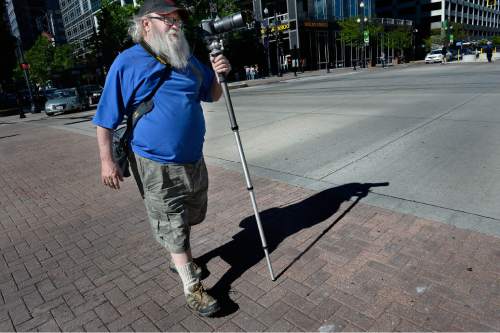This is an archived article that was published on sltrib.com in 2015, and information in the article may be outdated. It is provided only for personal research purposes and may not be reprinted.
Some of the photos in Jamie Cowen's new photo exhibit tell fragments of his story.
The mouse-nibbled pizza slice on the sidewalk tells of hunger and temptation. The panhandling sign in the garbage can evokes shame.
But none of the photos tell the story of the dark period when the former television cameraman pulled a blanket over his head and considered ways he could make himself die.
Cowen, 62, had forgotten what he has since rediscovered: his love of photography.
A show of his photos, shot in the 18 months since he began recovering from severe depression, opens Wednesday at the Tenth East Senior Center. A reception is planned from 2 p.m.-5 p.m. Wednesday, and the photos will remain up for a month.
Cowen had worked in television for 40 years, most of them as a photojournalist, when he was fired in late summer 2011 by KUTV, Channel 2, in Salt Lake City. He had worked there for 23 years.
It was only later that Cowen realized he was probably suffering from Post-Traumatic Stress Disorder (PTSD) in the difficult months before he was fired. Years of shooting scenes of violence and cruelty had taken a toll.
The day he lost his job, he turned in his camera gear and station truck and got a ride home.
He would spend the next few months there, sleeping most of the time, leaving only to buy beer or vodka. He didn't eat, but he eventually roused himself to apply for unemployment.
Nonetheless, by winter, Cowen had stopped paying for his utilities, so he was in the dark and had no heat. His water was turned off and he would sleep in his 115-year-old home wherever the roof wasn't leaking.
And the sobering thing was, nobody really knew.
Cowen realizes now that his job had become his life to such an extent that he had no other identity. A native of Scottsbluff, Neb., he had lost his parents and sisters, and had no other close family. He had friends, but no one he was willing to let see his troubles.
"I was a very private person. I didn't want to have that discussion with anybody and I didn't," Cowen says.
By early 2013, his waist size had dropped from 46 to 33, and he was panhandling on the streets of Salt Lake City, where he had once interviewed and videotaped panhandlers.
His placard said, "Please Help."
Cowen noted in his journal on a January day that he was given $40 by 15 people, charity that, he wrote, made him feel "worthy."
Still, he was scrounging and pawning possessions for one goal — buying a 9mm handgun so he could kill himself.
At the same time, he began to accept help from a pair of neighbors.
Darci Stilson and her partner would invite Cowen to shower at their home and to share a meal now and then, although Stilson says she feels guilty that it took her so long to reach out. In the end, her intervention and help from her partner, who prevented foreclosure by making Cowen's final house payments, were pivotal in Cowen's turnaround.
Cowen thought about suicide a lot, but had two epiphanies. The first was at the Salt Lake Library, where he was researching suicide methods. A British website argued that those committing suicide don't find relief. They don't live to feel anything.
Cowen found that persuasive. "It was logical."
He got rid of most everything he could pawn. But he kept his point-and-shoot camera and had it with him on a winter day when he was trudging home from the Tenth East Senior Center, where he would go for a free lunch.
A bundled up man and child were walking ahead of him. The girl wore a stuffed-animal backpack, a monkey with a long tail that the man held in his mittened hand.
Cowen shot the photo, and the next day it led to a second revelation — Cowen was that girl, with a monkey on his back. The photo, he says, reminded him that he was a photographer, not only a television cameraman.
So he started carrying his camera with him on photo walks, taking shots of whatever moved him. The products of those walks now comprise his exhibit.
Stilson could not be more thrilled with Cowen's recovery.
She was the one who persuaded him to apply for Social Security disability, and she prepared all the paperwork so he wouldn't have to hire an attorney.
He still suffers the effects of untreated gout and diabetes. When his disability status came through in March 2014, both of them were stunned.
For Cowen, it was a jolt of hope.
Stilson later helped him get a real estate agent to sell his home — he sold it on the condition it would be demolished — and Cowen bought a condo.
He is planning to work part-time for a new news website, and is learning software to help him work with his photos.
To those who are mired in depression and think suicide is the way out, Cowen has these words: "Your perspective is wrong.
"There is some value in there somewhere. You may not be able to see your worth."
kmoulton@sltrib.com Twitter: @KristenMoulton





